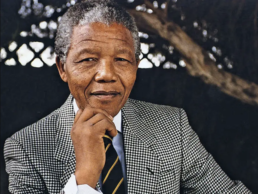These life stories may contain descriptions of childhood trauma and abuse, as well as images, voices and names of people now deceased. If you need help, you can find contact details for some relevant support services on our support page.
Esteemed anti-apartheid activist and President of South Africa from 1994 to 1999, Nelson Mandela (1918-2013), was in foster care as a child.
Nelson Rolihlahla Mandela was born in a small village, Mvezo, on the banks of the Mbashe River in South Africa. His father, Gadla Henry Mphakanyiswa, was a chief of Mvezo. His mother, Nosekeni Fanny, was the third wife as was the custom and Nosekeni raised Nelson with her extended family. When Gadla lost status and wealth, Nosekeni and Nelson moved to a village north of Mvezo, Qunu.
…it was in that village…that I spent some of the happiest years of my boyhood (Mandela, Long Walk, 8)
In primary school at Qunu the child was given the name ‘Nelson’.
Mandela’s father died when Nelson was nine years old. Chief Jongintaba Dalindyebo, acting regent of the Thembu people, offered to take Nelson in and care for him.
My mother had no choice; one did not turn down such an overture from the regent. She was satisfied that, although she would miss me, I would have a more advantageous upbringing in the regent’s care than in her own (Mandela, Long Walk, 20).
Once Nelson was a ward of the regent, he was rarely allowed to go home.
[The regent] would allow me only a few days to go home. On other occasions he would arrange for my mother to be fetched so that she could see me at the royal residence. It was always an exciting moment for me to visit Qunu and see my mother and sisters and other members of the family (Mandela, Conversations, 11)
When he was sixteen, Nelson was sent off to boarding school. He attended the Clarkebury Institute, an establishment of the Wesleyan Methodist Missionary Society. Three years later he attended Healdtown, another Wesley College, this time in Fort Beaufort, which “provided a Christian and liberal arts education based on an English model” (Mandela, Long Walk, 42).
From Healdtown, Nelson Mandela went on to get a Bachelor of Arts degree from the University of Fort Hare, at the time the only such educational facility for black people.
Fort Hare…was a beacon for African scholars from all over Southern, Central and Eastern Africa. For young black South Africans like myself, it was Oxford and Cambridge, Harvard and Yale, all rolled into one (Mandela, Long Walk, 51).
Mandela completed his degree at the University of South Africa and he was later able to practice law with a two-year diploma. He formed South Africa’s first black law firm with Oliver Tambo in 1952.
In 1964 Nelson Mandela was sent to prison on Robben Island for his role in the fight against apartheid. He was held on Robben Island until 1982, when he was transferred to Pollsmoor Prison in Cape Town. He spent the final two years in hospital and at the Victor Verster Prison. Nelson Mandela was finally released from prison on 11 February 1990.
…you may find that the cell is an ideal place to learn to know yourself, to search realistically and regularly the process of your own mind and feelings. In judging our progress as individuals we tend to concentrate on external factors such as one’s social position, influence and popularity, wealth and standard of education…But internal factors may be even more crucial in assessing one’s development as a human being (Mandela, Conversations, 211)
On 10 May 1994, Nelson Mandela became South Africa’s first democratically elected President. He stepped down after one term in office.
References:
Mandela, Nelson. Conversations with Myself. London, UK: Macmillan, 2010.
Mandela, Nelson. Long Walk to Freedom. London, UK: Abacus, 1994.
Nelson Mandela Foundation. https://www.nelsonmandela.org/
Image available here.
